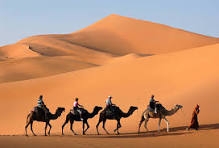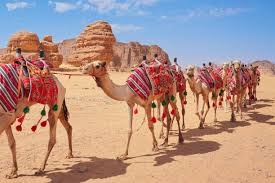The Camels Who Carried Empires Across the Desert

The Great Desert was the ultimate trial of endurance, a boundless expanse of shifting sands and searing heat that swallowed all but the most resilient. Across this formidable ocean of dunes moved the Camels, colossal beasts of legendary stoicism and unwavering purpose. They were the Carriers of Empires, the lifeline that connected distant civilizations and kept the pulse of global commerce beating.
These Camels, led by the ancient, scarred patriarch Sahib, symbolized Global Logistics, Supply Chain Networks, and Reliable Intercontinental Trade Routes. They represented the massive container ships, the sprawling rail networks, and the essential infrastructure that, though often slow and unglamorous, was the true bedrock of global power. Their strength lay not in aggression or cunning, but in unmatched endurance, reliability, and the sheer volume of wealth they could carry across impossible distances.

Sahib and his caravans moved with a majestic, unhurried pace. Their power was recognized universally because without them, the rich harvests of the Tigers would never reach the distant markets of the Lions, and the manufactured goods of the Stags would never cross the great landmasses. They were the indispensable link, the quiet giants that made the economic world turn.
The Value of Endurance
The Camels held a unique position of neutrality and respect among the other creatures. They tolerated the aerial surveillance of the Crows, knowing that intelligence was needed to secure their routes. They paid the demanded tolls to the Crocodiles at the river crossings, viewing it as a necessary, if tiresome, cost of business. They saw the chaotic infighting of the Baboons as a temporary, localized nuisance that rarely affected their long-distance mandate.
They understood the importance of long-term vision. While the Peacocks fussed over appearances and the Hyenas cackled over the latest scandal, the Camels focused on the unchanging constants: the position of the stars, the memory of the ancient wells, and the integrity of their cargo. They moved according to schedules measured in weeks and months, knowing that a steady pace always outlasted a frantic sprint.
Their greatest threat was not a predator, but disruption to the route itself—whether from unseasonal sandstorms (natural disaster) or, more frequently, from aggressive regional forces seeking to extract excessive tribute.

The Challenge of the Toll
A critical part of the Camels' trans-desert route led through a narrow, rocky pass known as the Iron Gate. This was the territory of the Serpents, a collection of highly decentralized, venomous reptiles who excelled at ambush and controlled the supply of rare, essential mineral salts found in the rocks.
The Serpents, led by the calculating Vipera, represented regional warlords, organized extortion rackets, or disruptive cyber-actors—small, potent forces that could inflict disproportionate damage on the global supply chain. They couldn't conquer the desert, but they could paralyze the flow that crossed it.
Vipera had recently become increasingly bold. Not content with the traditional, negotiated transit fee (a reasonable percentage of low-value goods), the Serpents began demanding an exorbitant "security tax" on the entire value of the Camels' cargo, threatening to sabotage the Iron Gate with rockslides and venom traps if their demands weren't met.
This was an attack on the very principle of free and reliable trade. If Sahib conceded, the precedent would shatter the entire global logistics network, as every minor gatekeeper would follow suit.
The Power of the Network
Sahib, faced with this critical bottleneck, did not resort to violence. He knew that even if his colossal Camels crushed every Serpent, the cost in time, injury, and potential route closure would be ruinous. Instead, he employed the power of the network.
He immediately sent swift, small riders—Jerboas—on circuitous routes, carrying coded messages to his distant partners.
-
To the Elephants (UN/World Bank): Sahib reported the exact coordinates and nature of the disruption, framed as a threat to global stability and a violation of all established trade conventions. This mobilized the Elephants' slow, bureaucratic machinery, pressuring the regional powers (the nearby Stags) to condemn the Serpents' actions.
-
To the Whales (Resource Providers): Sahib warned that the delay would impact the delivery of essential oil and minerals, causing a global price shock. This prompted the Whales to contact their own buyers—the Bulls and Tigers—creating immense economic pressure on the demand side.
-
To the Spiders (Hidden Influencers): Sahib subtly hinted that the Serpents' disruption was unraveling a complex, long-planned initiative (one of the Spiders' vast schemes) that relied on the timely arrival of the goods. The Spiders, fearing their own hidden agendas would be exposed, began to sow internal discord within the Serpents' political structure, undermining Vipera’s authority from within.
Sahib halted the main caravan. He did not retreat; he simply paused outside the Iron Gate. This act of visible, steadfast patience was a devastating move. The Serpent's power came from extortion on a moving target. By stopping the trade, Sahib transformed the Camels from victims into immense, static leverage. The global economy began to feel the pinch. The Stags' factories ran low on raw materials. The Lions' markets ran out of luxury goods.
Vipera, surrounded by the pressure generated by the global network, found his own followers restless. The Serpents relied on the transit fees for their own sustenance, and the halt in traffic meant zero income. Furthermore, the internal dissent, stoked by the Spiders, led to a localized skirmish among the Serpents themselves, further compromising their ability to maintain the blockade.
The Passage of Infrastructure
After a tense, two-week standoff that rocked international commodity prices, Vipera, defeated by the weight of global pressure, sent a single, reluctant Serpent to approach Sahib. The offer was a return to the original, reasonable toll.
Sahib, however, was not content with merely returning to the status quo. His endurance had bought him a greater victory.
"The price for my delay," Sahib rumbled, his voice low and steady, "is not gold. It is not even cargo. It is the right to build a reinforced, permanent bypass track around the Iron Gate. We will fund and maintain it. You may no longer interfere with the new route, though you may collect the old, negotiated toll from any lesser caravans who still choose the rocky path."
The Serpents had lost their bottleneck. They had traded their immediate, exorbitant demand for the permanent loss of their strategic choke point.
The Camels began the slow, methodical work of constructing the new Infrastructure Route. They moved with their accustomed patience, building a path designed for future resilience, ensuring that no single, small, extractive force could ever again hold the global trade system hostage.
Sahib led his caravan across the newly established track, his massive, enduring form a testament to the power of logistics, reliability, and the sheer, collective weight of the global supply chain against localized greed. The Camels continued their march, the lifeline of empires, proving that true power lay in the ceaseless, unglamorous dedication to the long road.
- Questions and Answers
- Opinion
- Motivational and Inspiring Story
- Technology
- Live and Let live
- Focus
- Geopolitics
- Military-Arms/Equipment
- Security
- Economy
- Beasts of Nations
- Machine Tools-The “Mother Industry”
- Art
- Causes
- Crafts
- Dance
- Drinks
- Film/Movie
- Fitness
- Food
- Games
- Gardening
- Health
- Home
- Literature
- Music
- Networking
- Other
- Party
- Religion
- Shopping
- Sports
- Theater
- Health and Wellness
- News
- Culture

